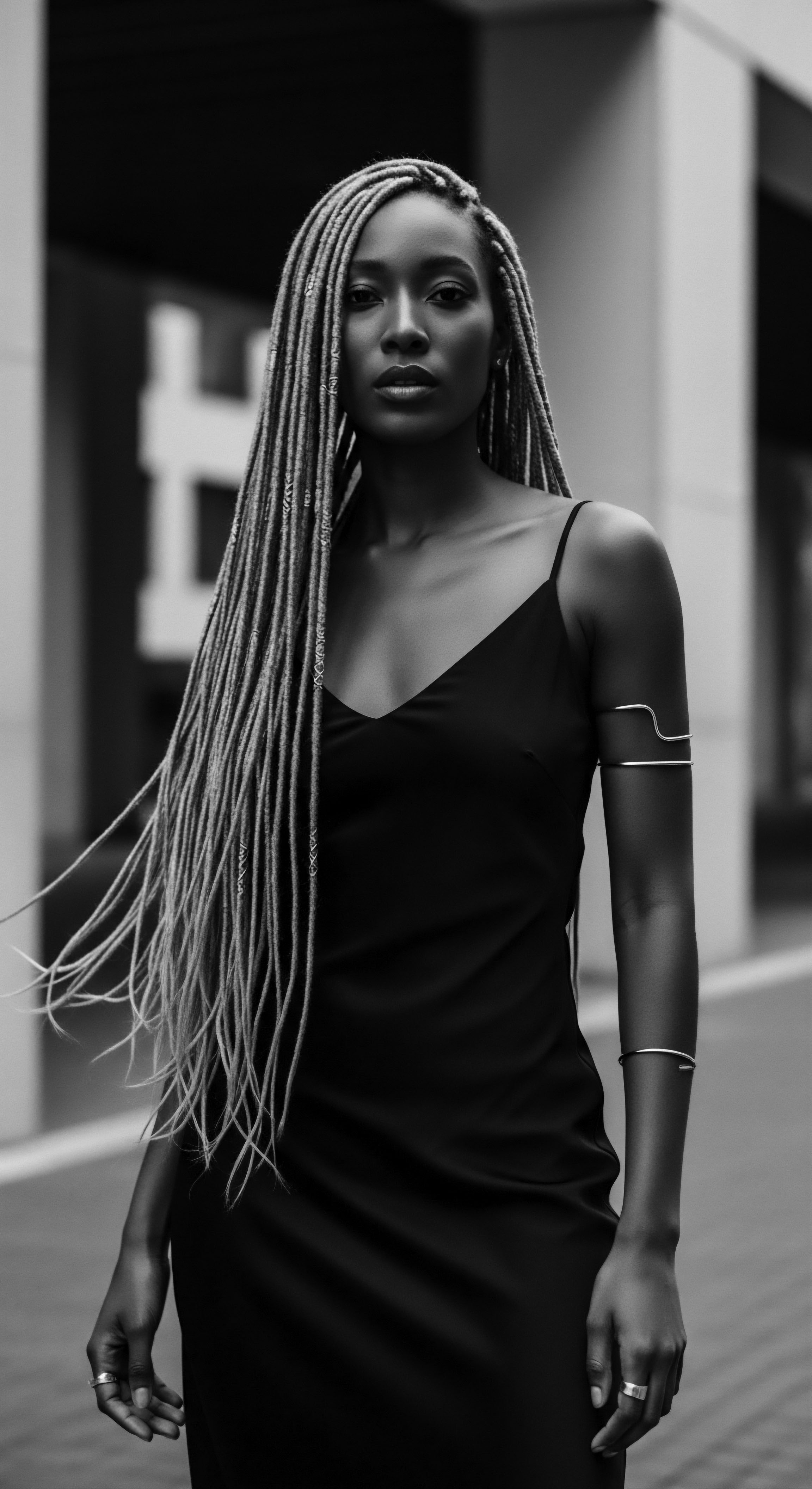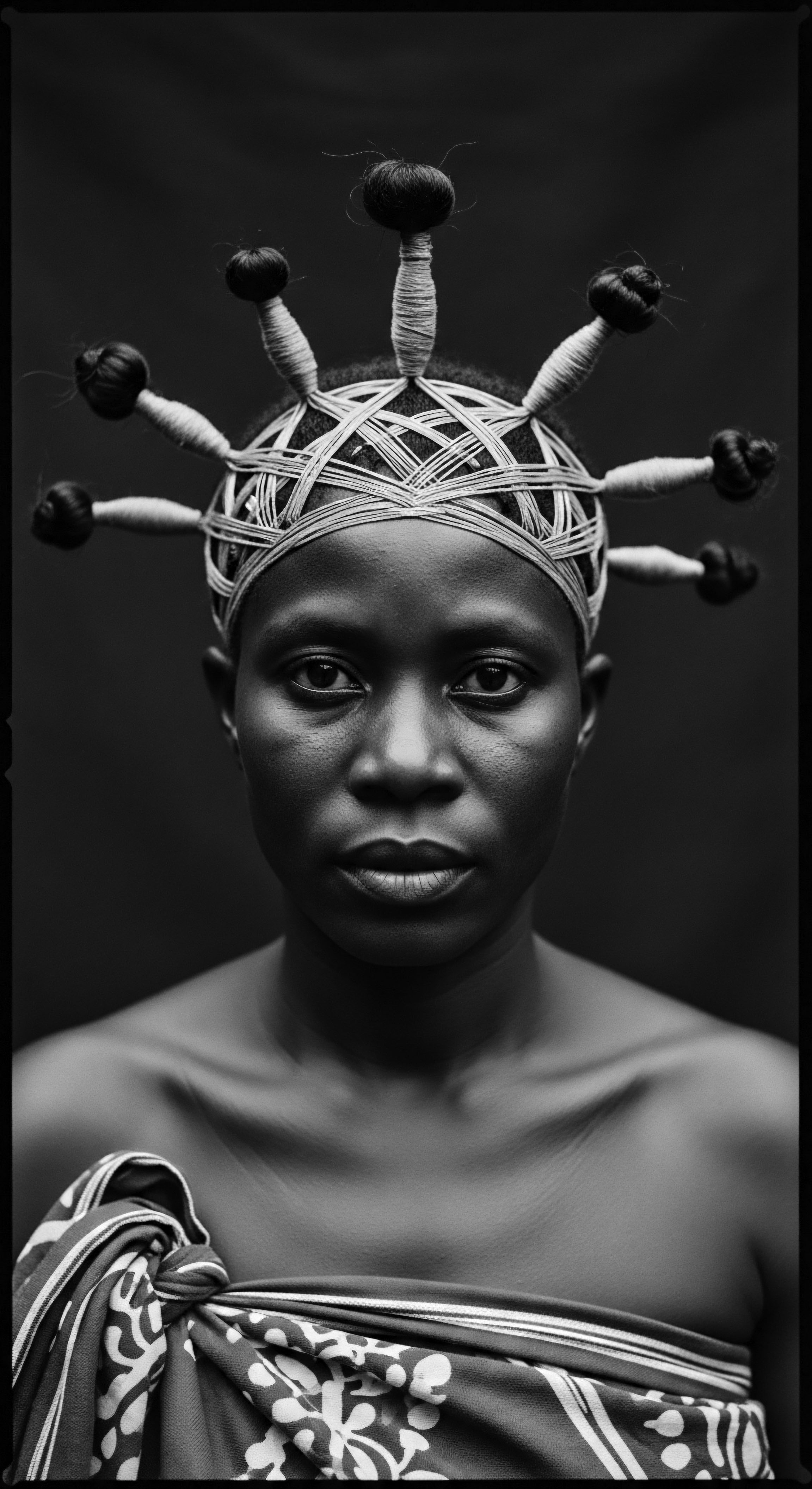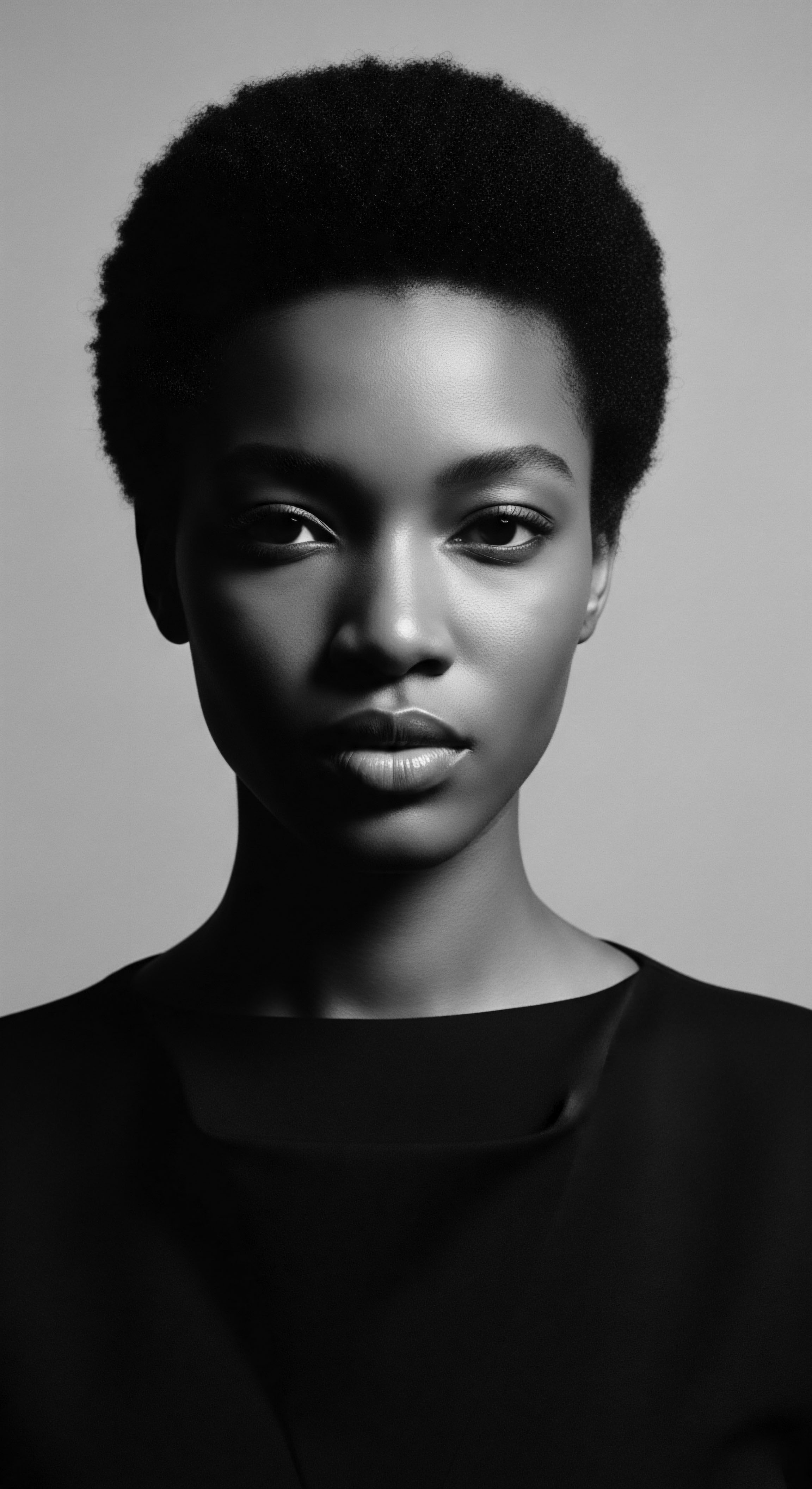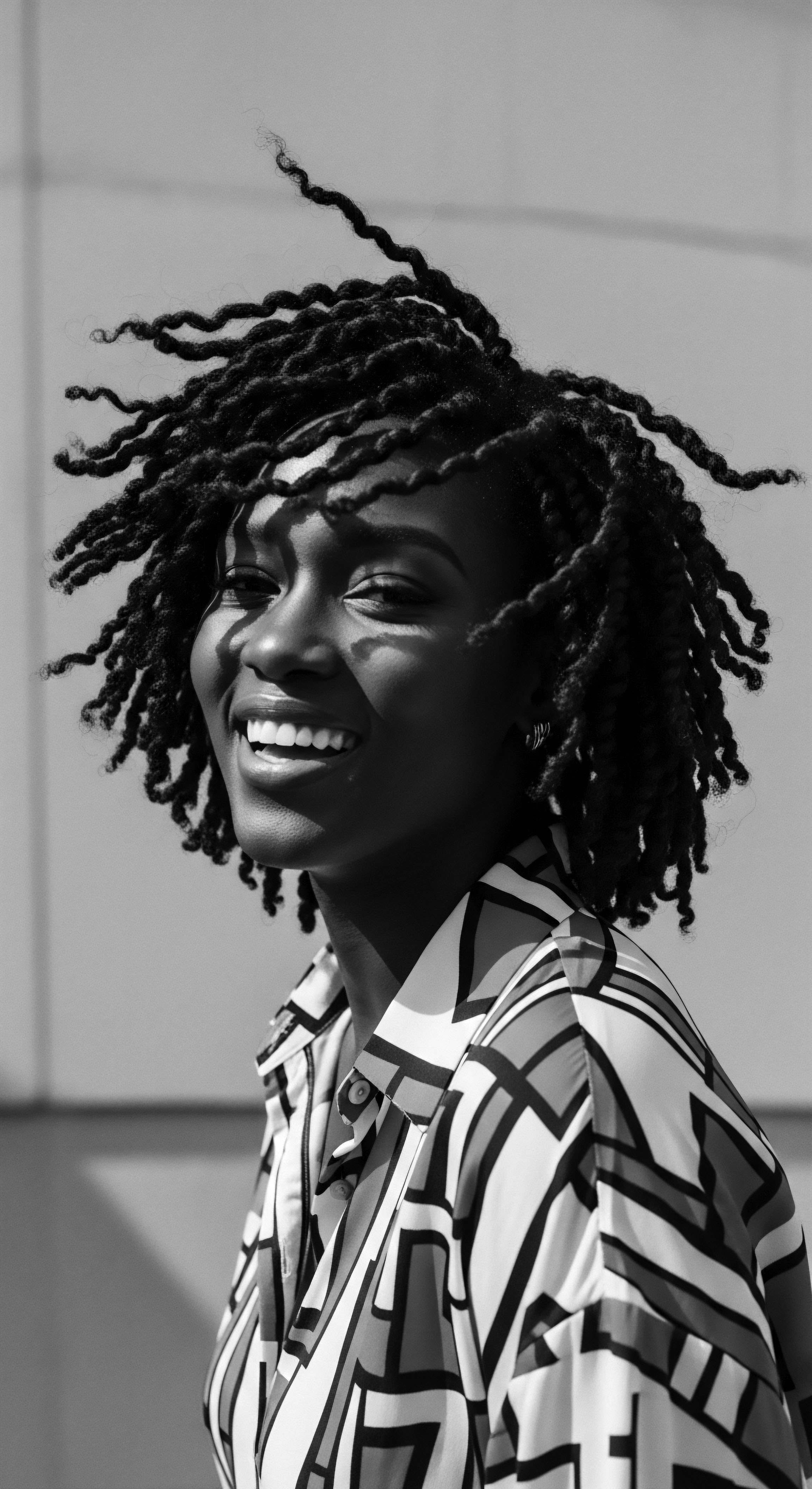
Roots
The coil, the curl, the resilient wave – these are not merely textures upon a head. They are living archives, each strand holding whispers of ancestral journeys, of resilience forged through sun-drenched savannahs and dense rainforests. For those of us with textured hair, the pursuit of moisture is a deeply felt quest, one that echoes a wisdom passed down through generations. Our hair, by its very architecture, often thirsts for hydration.
Its unique elliptical cross-section and the intricate coiling pattern make it a challenge for the scalp’s natural oils to travel the entire length of the strand, leaving ends particularly vulnerable to dryness. This inherent tendency for moisture loss means that for millennia, communities across Africa developed ingenious solutions, drawing directly from the abundant earth. These practices were not born of vanity, but of a profound understanding of the elements, a cultural imperative to care for the crown, which often signified identity, social standing, and spiritual connection. The ingredients used were not randomly chosen; they were gifts from the land, tested and affirmed by countless hands over uncounted seasons.

The Sacred Anatomy of Textured Hair
To truly appreciate the power of traditional African ingredients, one must first grasp the foundational truth of textured hair. Unlike straight or wavy hair, Afro-textured hair possesses a unique follicular structure. The hair follicle itself is elliptical and grows in a distinct curved pathway, causing the hair shaft to emerge from the scalp in a tight spiral. This curvature creates more points along the strand where the cuticle, the hair’s protective outer layer, can lift, making it easier for moisture to escape.
It also means that the sebum, the natural oil produced by the scalp’s sebaceous glands, finds a more winding path to travel from root to tip, leaving the length and ends drier than other hair types. This inherent characteristic is not a flaw, but a design that historically served its purpose in varying climates, offering insulation and protection. Understanding this biological blueprint helps us to see why ancestral practices focused so heavily on sealing and replenishing moisture, often using rich emollients and humectants.

Ancient Lexicon for Textured Strands
Across the African continent, hair was, and remains, a powerful visual language. Beyond mere adornment, hairstyles and the care rituals surrounding them conveyed stories of lineage, marital status, age, community role, and even spiritual beliefs. The terms used for hair and its care were deeply embedded in daily life, speaking to an intimate knowledge of hair’s properties and needs. While modern science offers terms like “hydrophilic” or “occlusive,” ancestral wisdom spoke through the observable effects of plants and butters.
The rich, unctuous shea butter from West Africa or the mineral-laden clay from the Atlas Mountains were understood by their tactile sensation, their ability to soften, to seal, to protect against the relentless sun and wind. These ingredients were not just commodities; they were living parts of a cultural heritage, each with a specific place in the care narrative.
For generations, the care of textured hair in Africa has been a dialogue between the unique architecture of the strand and the potent gifts of the earth.
Traditional African ingredients for hair moisture are those naturally occurring substances that communities across the continent have used for centuries to hydrate, seal, and protect textured hair. These often include plant-derived oils, butters, clays, and herbal concoctions. They are not merely components in a recipe; they are reflections of a profound, intergenerational knowledge base concerning the well-being of the scalp and strands. The efficacy of these ingredients stems from their natural properties, often rich in fatty acids, vitamins, minerals, and humectants, which cater precisely to the needs of hair prone to dryness.
The collective wisdom surrounding these ingredients often stems from observational science, passed down orally, through demonstration, and by communal practice. The understanding that certain plant butters formed a protective barrier, or that particular clays cleansed gently without stripping essential oils, was arrived at through repeated application and shared experience. This knowledge shaped not only individual hair care routines but also became a part of broader community rituals, signifying care, connection, and continuity. The ingredients were not just for aesthetic appeal; they contributed to the hair’s strength, its ability to withstand environmental stressors, and its symbolic representation of health and vitality within the community.
The connection between these traditional ingredients and textured hair heritage is undeniable. They are inextricably linked to the survival and flourishing of hair types that have historically faced marginalization and misunderstanding in global beauty standards. Using these ingredients today can be seen as an act of reclaiming, honoring, and continuing a legacy of self-care and cultural pride.
It is a tangible link to those who came before, a celebration of their ingenuity and their deep respect for the gifts of the land. The practices associated with these ingredients often transcend individual application, becoming moments of communal bonding, storytelling, and the transmission of invaluable wisdom.

Ritual
The journey of textured hair care has always extended beyond mere product application; it is steeped in ritual, in practices that transform a simple act of grooming into a moment of reverence and communal connection. For centuries, across the African continent, the application of moisturizing ingredients was not a solitary task but often a shared experience, a time for intergenerational bonding and the imparting of wisdom. These rituals, whether daily acts of replenishment or more ceremonial preparations, cultivated a deep sense of self-worth and communal identity.

The Daily Rites of Moisture
In many African societies, the daily care of hair involved consistent application of nourishing substances. These were not quick fixes, but rather a methodical layering of nature’s bounty to ensure the hair remained supple, pliable, and resilient. The emphasis was on maintaining a healthy moisture balance, protecting the strands from environmental elements, and preparing them for intricate styling. Such daily rituals became a rhythm, a quiet affirmation of self-care and continuity.
- Shea Butter ❉ From the shea tree, abundant in West Africa, this rich, creamy butter has been a cornerstone of traditional hair care for millennia. Its properties allow it to seal moisture onto the hair shaft, providing a protective barrier against dryness and environmental aggressors. Women would melt it gently, applying it from root to tip, sometimes braiding the hair afterward to lock in its goodness. It is rich in vitamins A, E, and F, acting as a deep conditioner and helping to reduce breakage.
- Baobab Oil ❉ Extracted from the seeds of the majestic “Tree of Life” found across many African savannahs, baobab oil is celebrated for its lightweight yet deeply conditioning properties. It is rich in omega fatty acids, which readily penetrate the hair strand, softening and improving elasticity without weighing hair down. Its use historically extended to soothing dry scalps and fortifying fragile strands against breakage.
- Moringa Oil ❉ Known as “Ben Oil” in ancient Egypt, this light oil from the Moringa oleifera tree has been used for over 6,000 years for its restorative properties. It is packed with vitamins, minerals, and amino acids, nourishing the scalp and hair. Its ability to absorb and retain scents also made it a choice carrier oil in ancient perfumes, underscoring its versatility beyond mere moisturization.

How Does Community Shape Hair Care Rituals?
The individual act of caring for hair often unfolded within a communal setting. Hair grooming was a social activity, strengthening familial bonds and fostering a sense of shared heritage. For example, the Basara women of Chad are renowned for their use of Chebe Powder, a blend of indigenous plants that has been passed down through generations. Their ritual involves coating hair strands with a mixture of Chebe powder, oils, and animal tallow, then braiding the hair to seal in the moisture.
This is not a solitary endeavor; older women typically apply the treatment for younger members of the tribe, creating a deeply ingrained intergenerational practice. This consistent method of moisturizing and protecting their coarse hair is credited with its exceptional length and strength, reaching often to the thighs. The ritual itself, laborious and time-consuming, signifies the value placed on hair care and community.
Ancestral hair practices transcend simple conditioning, becoming communal narratives woven into the very fabric of identity.
Another powerful example of a traditional moisture-supporting practice is the use of Rhassoul Clay, particularly prevalent in Moroccan traditions. This mineral-rich clay, sourced from the Atlas Mountains, has been integral to hammam rituals for centuries. It cleanses the hair and scalp without stripping natural oils, making it an ideal pre-treatment for deep moisturization. When mixed with water or rosewater, it creates a paste that gently purifies, leaving hair softened and prepared to absorb subsequent nourishing oils and butters.
Its unique ability to balance sebum production means it addresses both oily and dry scalp concerns, creating an optimal environment for moisture retention. Families have passed down recipes and application methods for Rhassoul clay, making it a cultural heritage item.

The Protection of Nighttime Sanctuary
The understanding that hair needs protection, especially during sleep, is not a modern innovation. Ancestral wisdom recognized the importance of preserving hair’s moisture and integrity overnight. While bonnets as we know them today are more contemporary, the practice of wrapping or covering hair for protection is deeply rooted. In many communities, scarves and wraps were used not only for ceremonial purposes or everyday adornment but also as practical tools to shield hair from external elements and prevent moisture loss.
This foresight prevented friction against rough surfaces and maintained applied moisture, showcasing a long-standing commitment to hair health. The use of natural fibers like silk, or simply the strategic wrapping of cloth, created a micro-environment that preserved the hair’s delicate moisture balance.

Relay
The lineage of knowledge concerning traditional African ingredients for hair moisture extends far beyond historical anecdotes. It is a living, evolving understanding where the wisdom of our forebears converges with contemporary scientific inquiry. Modern research, increasingly, validates the efficacy of these age-old practices, offering insights into the molecular mechanisms behind their moisturizing power. This relay of knowledge bridges eras, affirming that ancestral methods are not simply cultural relics but potent, effective approaches to hair health.

The Science Behind Ancestral Hydration
The efficacy of traditional African ingredients in supporting hair moisture lies in their rich biochemical compositions. These natural compounds work in concert with the hair’s unique structure, providing humectant, emollient, and occlusive properties essential for hydration and retention. Understanding the ‘why’ behind the ‘what’ reinforces the ingenuity of ancestral practices.
Consider Shea Butter (Vitellaria paradoxa), often hailed as “women’s gold.” Its moisturizing capability is attributed to its high concentration of fatty acids, particularly oleic acid and stearic acid, alongside beneficial unsaponifiable lipids, and vitamins A, E, and F. These components work in multiple ways. The fatty acids provide emollients that soften the hair, while the unsaponifiables act as a protective barrier on the hair shaft, reducing transepidermal water loss.
This occlusive layer helps to seal in moisture, making it particularly effective for porous, textured strands. A historical survey of hair care practices in African populations notes the widespread use of natural butters for moisture retention, affirming this long-understood benefit.
Baobab Oil (Adansonia digitata), another cherished African gift, stands out for its balanced profile of fatty acids, including oleic, linoleic, and palmitic acids. This unique blend allows the oil to penetrate the hair shaft effectively, nourishing from within, while also conditioning the surface. The presence of omega-3 fatty acids contributes to scalp health, which is foundational for healthy, moisturized hair growth.
Its lightweight nature means it delivers intense hydration without feeling heavy, making it suitable for a range of textured hair types. Traditional Senegalese pharmacopoeia, for instance, has long recognized baobab oil for its emollient and softening capabilities, applied to dry, brittle hair.
Even certain clays, like Moroccan Rhassoul Clay (also known as Ghassoul Clay), contribute to moisture through their unique cleansing action. Unlike harsh shampoos that strip the hair of its natural oils, Rhassoul clay contains minerals like magnesium, silica, and calcium that draw out impurities and excess sebum without disturbing the hair’s delicate hydrolipidic film. By preserving this natural barrier, the hair is better able to retain its intrinsic moisture, rather than being left parched after cleansing. This gentle yet effective purification prepares the hair for subsequent moisturizing treatments, laying the groundwork for sustained hydration.

Are Ancestral Practices Supported by Modern Data?
While direct clinical trials on specific traditional African hair care rituals are still developing within Western scientific frameworks, a growing body of ethnobotanical research and general scientific understanding supports their underlying principles. The emphasis on gentle cleansing, consistent oiling, and protective styling within African heritage hair care aligns remarkably well with modern recommendations for maintaining moisture in textured hair.
For instance, the Basara women’s Chebe ritual, involving the application of Chebe powder mixed with oils and tallow, highlights a practice centered on preventing breakage and retaining moisture, rather than directly stimulating growth. Research suggests that while there is no clinical data directly linking Chebe to accelerated hair growth, its use in a moisturizing, occlusive mask certainly aids in strengthening hair and improving moisture retention, thus preventing the breakage that often hinders length. This indirect contribution to length, through the preservation of existing hair, underscores the practical effectiveness of the tradition. It is a powerful illustration of how traditional methods, even without modern scientific terminology, achieved tangible results by understanding the hair’s needs.
The enduring relevance of African ancestral hair care lies in its profound understanding of hair’s fundamental needs, echoed and affirmed by contemporary science.
The widespread use of protective styles in traditional African communities, often facilitated by these moisturizing ingredients, also finds strong backing in modern hair science. Protective styles minimize manipulation, reduce exposure to environmental damage, and help lock in moisture, all critical for textured hair health. The knowledge that braiding hair after applying moisturizing butters and oils helps seal in hydration, for example, is a testament to centuries of observation and applied understanding. This approach directly counters the natural tendency of coiled hair to lose moisture rapidly.

The Continuing Lineage of Care
The legacy of these traditional ingredients and practices extends into the contemporary landscape of textured hair care. Many communities in the diaspora actively seek out and reintegrate these ancestral components into their routines, recognizing their inherent value and the cultural connection they provide. The accessibility of ingredients like shea butter and baobab oil in global markets today allows for a broader appreciation of their benefits, but it is important to remember their origins and the rich traditions from which they stem.
The relay of knowledge also manifests in new ways, as scientists study the compounds within these plants and their effects. This scientific validation helps to dismantle historical biases against textured hair and its traditional care, elevating ancestral wisdom to its rightful place alongside modern dermatological understanding. The enduring presence of these ingredients in contemporary products and practices underscores a continuity of care that transcends time and geography.
| Ingredient Shea Butter |
| Traditional Use Context West African communities for centuries, for skin protection and hair nourishment, often applied after washing and before braiding. |
| Modern Scientific Link to Moisture Rich in oleic and stearic fatty acids; forms an occlusive barrier to seal in moisture and reduce water loss. |
| Ingredient Baobab Oil |
| Traditional Use Context Used across Africa for emollient properties, softening dry hair and scalp, often passed down through family rituals. |
| Modern Scientific Link to Moisture Contains omega-3, -6, and -9 fatty acids; lightweight, penetrates hair to nourish and improve elasticity. |
| Ingredient Moringa Oil |
| Traditional Use Context Ancient Egyptian royal women used it for skin and hair protection from sun and wind; also as a perfume base. |
| Modern Scientific Link to Moisture Rich in behenic acid and vitamins A, E, C; provides deep conditioning and supports healthy scalp for moisture retention. |
| Ingredient Chebe Powder |
| Traditional Use Context Basara women of Chad apply it as a protective coating with oils/tallow to prevent breakage and retain length. |
| Modern Scientific Link to Moisture While not a direct moisturizer, its application ritual seals in moisture and protects the hair shaft, preventing dryness and breakage. |
| Ingredient Rhassoul Clay |
| Traditional Use Context Integral to Moroccan hammam cleansing rituals for skin and hair, purifying without stripping natural oils. |
| Modern Scientific Link to Moisture Mineral-rich clay that gently cleanses, balances sebum, and preserves the hair's natural hydrolipidic film, aiding moisture retention. |
| Ingredient This table highlights the persistent wisdom embedded in ancestral hair care, where traditional application methods often align with contemporary understanding of hair physiology. |
This interplay between historical practice and modern validation is a beautiful affirmation of the ‘Soul of a Strand’ ethos. It reminds us that the most effective solutions for textured hair have often been right there, in the soil, in the trees, and in the hands that meticulously applied them for countless generations.

Reflection
The journey through the ancestral wellspring of African ingredients that support hair moisture concludes not with a period, but with an open horizon. Our exploration has traversed the intimate biology of textured strands, lingered in the sacred spaces of communal ritual, and found resonance in the affirming gaze of scientific inquiry. What remains, at the heart of it all, is a profound recognition of heritage – a deep, enduring connection to the ingenuity and wisdom of those who came before. The coils and curls, often misunderstood in dominant beauty narratives, become luminous pathways back to a time when self-care was inextricably linked to land, community, and identity.
The ingredients themselves – the plump shea nut yielding its golden balm, the towering baobab sharing its seed’s liquid gold, the ancient clay from mountain depths, and the powdered blessing of Chebe – are more than mere substances. They are tangible links to a legacy of resilience, of beauty forged in challenging climates, and of a knowingness that transcended written word. To engage with them today is to participate in a living tradition, to honor the hands that first discovered their properties, and to acknowledge the cultures that preserved this invaluable knowledge against overwhelming forces.
The act of moisturizing textured hair with these gifts is not simply about physical hydration; it is a spiritual replenishment, a connection to a collective memory of survival and self-definition. It is a quiet, powerful act of homage to every ancestor who understood the inherent preciousness of the crown.
This ongoing conversation between the past and the present, between tradition and innovation, illuminates the path forward for textured hair care. It challenges us to look beyond fleeting trends and commercial promises, directing our gaze towards the deep roots of natural efficacy and cultural significance. For every strand, every curl, every wave, carries within it the undeniable imprint of history, a silent testament to the enduring ‘Soul of a Strand’ – vibrant, cherished, and forever connected to its source.

References
- Byrd, Ayana, and Lori L. Tharps. Hair Story ❉ Untangling the Roots of Black Hair in America. St. Martin’s Press, 2001.
- Sherrow, Victoria. Encyclopedia of Hair ❉ A Cultural History. Greenwood Press, 2006.
- Fatima’s Garden. Frequently Asked Questions about Rhassoul Clay (Ghassoul Clay). 2024.
- Fatima’s Garden. Rhassoul Clay. 2024.
- BIOVIE. What are the benefits of rhassoul clay? 2024.
- ARKIVE© Headcare. Baobab Oil for Healthy Hair ❉ Uses & Benefits. 2023.
- Holy Curls. Why is baobab oil great for curly hair? 2021.
- Tattvalogy. Baobab Oil ❉ Nature’s Gift for Radiant Skin and Luscious Hair. 2023.
- NATURAL POLAND. Africa’s Treasured Oils ❉ Argan vs. Baobab. 2023.
- Jennifer Luis Haircare. The Magic Benefits of Moringa oil for Hair. 2023.
- Naturali. Moringa Oil 101 ❉ Everything You Need To Know About Liquid Gold. 2024.
- Panya Natural. A Timeless Beauty ❉ The History and Uses of Moringa Oil. 2023.
- Africa Moringa Hub. Moringa Oil – Its Origins and Its Uses. 2022.
- Ciafe. Shea Butter – Explainer. 2023.
- sheabutter.net. A History of Shea Butter.
- African American Registry. Black Hair Care and Its Culture, a story.
- BLAM UK CIC. The history of Black Hair. 2022.
- Afriklens. African Hairstyles ❉ Cultural Significance and Legacy. 2024.
- The Gale Review. African Hairstyles – The “Dreaded” Colonial Legacy. 2021.
- Assendelft. Pre-Colonial African Hairstyles ❉ A Journey Through Time and Culture.
- Odele Beauty. 6 Things Everyone Should Know About Black Hair History. 2021.
- Byrdie. Chebe Powder—The Long-Hair Secret You Should Know About. 2023.
- Chebeauty. The Magic of Chebe Powder ❉ A Guide to Stronger, Longer Hair. 2023.
- SEVICH. The Cultural Background and History of Chebe Powder.
- YouTube. Chad Magical Chebe Powder Giving Africans Long Natural Hair. 2022.
- Obscure Histories. Ancient Gems ❉ A Historical Survey of African Beauty Techniques. 2024.
- Ethnobotany Research and Applications. Plants used for hair and skin health care by local communities of Afar, Northeastern Ethiopia. 2025.
- Juniper Publishers. Cosmetic Ethnobotany Used by Tribal Women in Epe Communities of Lagos State, Nigeria. 2024.
- EBSCO Research Starters. Afro-textured hair.
- MDPI. Cosmetopoeia of African Plants in Hair Treatment and Care ❉ Topical Nutrition and the Antidiabetic Connection? 2024.
- ELLE. A Brief History Of Black Hair Rituals. 2020.
- Historical Perspectives on Hair Care and Common Styling Practices in Black Women. 2025.
